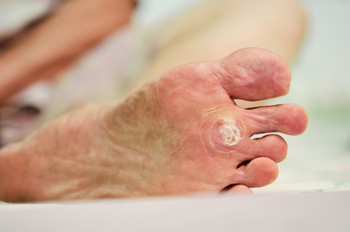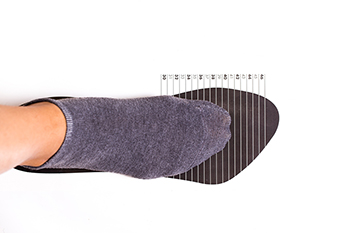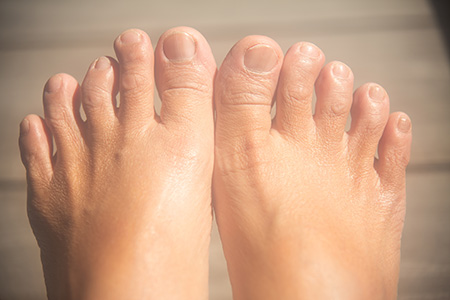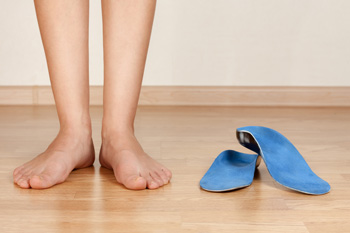Items filtered by date: October 2024
Keep Your Feet Healthy So You Can Stay Active
Simple to Serious Causes of Swollen Feet

Having swollen feet, also known as foot edema, is a common issue that can occur for a variety of reasons. Simple causes include standing or sitting for long periods of time, especially in hot weather, which can lead to fluid retention. Minor injuries, such as sprains or strains, can also cause temporary swelling. However, persistent or severe swelling could signal more serious health conditions. Heart failure, kidney disease, and liver disorders can all cause fluid buildup in the lower extremities. Venous insufficiency, where the veins struggle to return blood to the heart, is another possible cause. Blood clots in the legs or infections can also trigger swelling. Treatment depends on the underlying cause. For mild cases, elevating the feet and reducing salt intake may help. If you have swollen feet from an unknown cause and especially if accompanied by pain, shortness of breath, or other symptoms, it is suggested that you contact a podiatrist promptly for an evaluation and care.
Swollen feet can be a sign of an underlying condition. If you have any concerns, contact Yvonne Umezurike, DPM of Umez Podiatry. Our doctor can provide the care you need to keep you pain-free and on your feet.
Swollen feet are a common ailment among pregnant women and people who stand or sit for extended periods. Aging may increase the possibility of swollen feet and patients who are obese often notice when their feet are swelling too. There may be medical reasons why swollen feet occur:
- Phlebitis - A condition that causes the veins to become inflamed and can also cause leg pain.
- Liver disease - This may lead to low blood levels of albumin which is a protein. This can cause fluid in the blood to pass into the tissues and several areas of the body can become swollen.
- Heart failure - When the heart doesn’t pump properly the blood that is normally pumped back to the heart can pool in the veins of the legs causing swollen feet.
- Kidney disease - One of the main functions of the kidneys is releasing excess fluid in the body. This type of condition can make it difficult for the kidneys to function properly, and as a result the feet may become swollen.
- Deep-vein thrombosis (DVT)- This is a serious condition where blood clots form in the veins of the legs. They can block the return of blood from the legs to the heart which may cause the feet to swell. It is important to be treated by a podiatrist if this condition is present.
Swollen feet can also be caused by bone and tendon conditions, including fractures, arthritis, and tendinitis. Additionally, there may be skin and toenail conditions and an infection may cause the feet to swell. Patients who take medicine to treat high blood pressure may be prone to getting swollen feet.
Many patients elevate their feet to help relieve the swelling and this is generally a temporary remedy. When a podiatrist is consulted the reason behind the swelling can be uncovered and subsequently treated.
If you have any questions please feel free to contact our offices located in Baltimore, MD and Washington DC . We offer the newest diagnostic tools and technology to treat your foot and ankle needs.
Treatment of Plantar Warts

Plantar warts are growths that appear on the soles of the feet, caused by the human papillomavirus, or HPV. They occur when the virus enters the skin through tiny cuts or breaks, often from walking barefoot in moist environments like locker rooms or public pools. Children, teenagers, and people with weakened immune systems are more prone to developing plantar warts. These warts usually look like small, rough, grainy bumps with tiny black dots, which are clotted blood vessels. They can be painful, especially when walking or standing, as pressure pushes the wart inward, causing discomfort. Plantar warts are contagious and can spread. Treatment options include cryotherapy, or freezing the wart, or stronger treatments. If you have a plantar wart that is painful or spreading, it is suggested that you visit a podiatrist for proper removal and to prevent spreading the virus to other areas of the foot or body.
Plantar warts can be very uncomfortable. If you need your feet checked, contact Yvonne Umezurike, DPM from Umez Podiatry. Our doctor will assist you with all of your foot and ankle needs.
About Plantar Warts
Plantar warts are the result of HPV, or human papillomavirus, getting into open wounds on the feet. They are mostly found on the heels or balls of the feet.
While plantar warts are generally harmless, those experiencing excessive pain or those suffering from diabetes or a compromised immune system require immediate medical care. Plantar warts are easily diagnosed, usually through scraping off a bit of rough skin or by getting a biopsy.
Symptoms
- Lesions on the bottom of your feet, usually rough and grainy
- Hard or thick callused spots
- Wart seeds, which are small clotted blood vessels that look like little black spots
- Pain, discomfort, or tenderness of your feet when walking or standing
Treatment
- Freezing
- Electric tool removal
- Laser Treatment
- Topical Creams (prescription only)
- Over-the-counter medications
To help prevent developing plantar warts, avoid walking barefoot over abrasive surfaces that can cause cuts or wounds for HPV to get into. Avoiding direct contact with other warts, as well as not picking or rubbing existing warts, can help prevent the further spread of plantar warts. However, if you think you have developed plantar warts, speak to your podiatrist. He or she can diagnose the warts on your feet and recommend the appropriate treatment options.
If you have any questions please feel free to contact our offices located in Baltimore, MD and Washington DC . We offer the newest diagnostic and treatment technologies for all your foot and ankle needs.
Measuring Feet for Proper Shoe Sizing

Measuring feet for proper shoe sizing is imperative for comfort and preventing foot problems. To get the most accurate size, measure your feet at the end of the day when they are at their largest. Use a ruler or foot-measuring tool to assess the length from heel to toe and the width at the widest point. It is important to measure both feet, as one foot is often slightly larger. Shoes should fit the larger foot. A podiatrist can provide expert guidance in finding the right shoe size, especially if you have foot issues like bunions, hammertoes, or flat arches. They can assess your foot structure and recommend orthotics or custom shoes for optimal support. A podiatrist can also help treat any foot-related problems that arise from wearing improper footwear and offer advice on the best shoes for different activities to prevent future discomfort or injury. If you have foot problems or need help in selecting well-fitting shoes, it is suggested that you consult a podiatrist.
Getting the right shoe size is an important part of proper foot health. Seek the assistance of Yvonne Umezurike, DPM from Umez Podiatry. Our doctor will provide the care you need to keep you pain-free and on your feet.
Getting the Right Shoe Size
There are many people who wear shoes that are the incorrect size, negatively affecting their feet and posture. Selecting the right shoes is not a difficult process, so long as you keep several things in mind when it comes to choosing the right pair.
- When visiting the shoe store, use the tools available to measure your foot.
- Be sure there is ‘wiggle room’. There should be about an inch between your toes and the tip of your shoes.
- Do not always assume you are the same size, as manufacturers run differently.
- Purchase shoes later in the day, as your feet swell as the day progresses.
- If a shoe is not comfortable, it is not suitable. Most shoes can’t be ‘broken in’, and comfort should be the ultimate goal when it comes to choosing the right pair of shoes
As our feet hold our body weight and keep us moving, it is important to treat them right. Picking the right pair of shoes can provide your feet comfort and mobility without pain.
If you have any questions, please feel free to contact our offices located in Baltimore, MD and Washington DC . We offer the newest diagnostic and treatment technologies for all your foot care needs.
What Is Splayfoot?

Splayfoot is a condition where the metatarsal bones, the long bones in the middle of the foot that connect the ankle to the toes, spread out, causing the forefoot to widen and the arch to flatten. This can lead to discomfort or pain, particularly during walking or standing for long periods of time. The condition often arises from wearing ill-fitting or unsupportive shoes, prolonged standing, or carrying excess weight, and it can be made worse by activities that put repetitive stress on the feet. Splay foot is commonly seen in individuals with jobs that require long hours on their feet, older adults, and those with a genetic predisposition to weaker foot structures. If you suffer from the ill effects of splay foot, it is suggested that you visit a podiatrist for a proper diagnosis and treatment.
Some foot conditions may require additional professional care. If you have any concerns, contact Yvonne Umezurike, DPM of Umez Podiatry. Our doctor can provide the care you need to keep you pain-free and on your feet.
Rare Foot Conditions
The majority of foot conditions are common and can be treated by a podiatrist. Standard diagnostic procedures are generally used to identify specific conditions and treatment can be rendered. A podiatrist also treats rare foot conditions which can be difficult to diagnose and may need extra attention and care.
There are many rare foot conditions that can affect children. Some of these can include:
- Freiberg’s disease
- Kohler’s disease
- Maffucci syndrome
Freiberg’s disease - This can be seen as a deterioration and flattening of a metatarsal bone that exists in the ball of the foot. It typically affects pre-teen and teenage girls, but can affect anyone at any age. Symptoms that can accompany this can be swelling, stiffness, and the patient may limp.
Kohler’s disease - This often targets the bone in the arch of the foot and affects younger boys. It can lead to an interruption of the blood supply which ultimately can lead to bone deterioration. The patient may limp or experience tenderness, swelling, and redness.
Maffucci syndrome - This affects the long bones in a child’s foot leading to the development of abnormal bone lesions. They are benign growths and typically develop in early childhood and the bones may be susceptible to breaking.
A podiatrist can properly diagnose and treat all types of rare foot conditions. If your child is affected by any of these symptoms or conditions, please don’t hesitate to call our office so the correct treatment method can begin.
If you have any questions please feel free to contact our offices located in Baltimore, MD and Washington DC . We offer the newest diagnostic tools and technology to treat your foot and ankle needs.
All About Orthotics

Orthotics are specialized inserts designed to improve foot function and alignment. While experts debate exactly how they work, key theories suggest they correct muscle activity and place the foot in a better position to distribute weight more evenly, reducing strain on muscles and joints. Orthotics are used to treat a range of conditions, from flat feet and plantar fasciitis to chronic pain in the ankles, knees, and lower back. The growing industry offers custom made orthotics, tailored to individual needs based on factors like gait, foot structure, and body weight. Custom options consider these factors to provide precise support and relief. As understanding of biomechanics improves, orthotics continue to evolve, becoming more effective in alleviating foot-related issues and enhancing overall comfort and mobility. If you are interested in learning if orthotics can help you relieve foot and body pain, it is suggested that you consult a podiatrist for further discussion.
If you are having discomfort in your feet and would like to try orthotics, contact Yvonne Umezurike, DPM from Umez Podiatry. Our doctor can provide the care you need to keep you pain-free and on your feet.
What Are Orthotics?
Orthotics are inserts you can place into your shoes to help with a variety of foot problems such as flat feet or foot pain. Orthotics provide relief and comfort for minor foot and heel pain but can’t correct serious biomechanical problems in your feet.
Over-the-Counter Inserts
Orthotics come in a wide variety of over-the-counter inserts that are used to treat foot pain, heel pain, and minor problems. For example, arch supports can be inserted into your shoes to help correct overarched or flat feet, while gel insoles are often used because they provide comfort and relief from foot and heel pain by alleviating pressure.
Prescription Orthotics
If over-the-counter inserts don’t work for you or if you have a more severe foot concern, it is possible to have your podiatrist prescribe custom orthotics. These high-quality inserts are designed to treat problems such as abnormal motion, plantar fasciitis, and severe forms of heel pain. They can even be used to help patients suffering from diabetes by treating foot ulcers and painful calluses and are usually molded to your feet individually, which allows them to provide full support and comfort.
If you are experiencing minor to severe foot or heel pain, it’s recommended to speak with your podiatrist about the possibilities of using orthotics. A podiatrist can determine which type of orthotic is right for you and allow you to take the first steps towards being pain-free.
If you have any questions please contact our offices located in Baltimore, MD and Washington DC . We offer the newest diagnostic and treatment technologies for all your foot and ankle needs.

